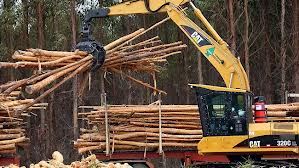
When considering a 1031 exchange on the sale of timberland, there are a number of factors that need to be examined. Timber transactions may vary from simply selling a piece of land that has timber standing on it, to selling the rights to harvest, or just to leasing the land. The specific rights being granted– and the term of these rights– must all be considered. The conveyance document being used, the seller’s intent, and applicable state law can be additional variables. Despite the complexity, though, a successful exchange is usually still achievable.
In perhaps the simplest situation, if an owner is selling forested land, even if the harvestable timber adds value to the sale, the entire transaction is viewed as a sale of real property for 1031 purposes. As early as 1863, the Supreme Court ruled that “timber growing upon the land constituted a portion of the realty.” Therefore, the owner can sell his forested land and exchange into other “like-kind” real estate such as apartments —without replacing the value of the timber separately from that of the land. However, if the owner cuts and sells the timber, the cut timber would be considered personal property—and no longer be like-kind with real property.
Let’s briefly review the qualified property and like-find requirements. Qualified property for a 1031 exchange is defined as “property used in a trade or business or held for investment”. Generally speaking, if the property being sold is not a primary residence, a 2nd home used almost exclusively for personal use or as inventory, it will probably qualify. Owners can execute exchanges on most investment real estate as long as the relinquished and replacement properties are considered “like-kind” with one another. The definition of like-kind for real property is very broad: undeveloped land, office, industrial, retail, apartments, farm land and long-term leasehold interests (30 years or longer) are all considered like-kind. Personal property, however, is not like-kind with real estate.
 In a typical sale of real estate, all ownership rights are transferred by conveyance of a fee simple interest, usually by a deed. Blacks Law Dictionary defines this type of interest as “an estate limited absolutely to a person, his or her heirs and assigns forever without limitation or condition…Such an estate is unlimited as to duration, disposition, descendability.” Perhaps another way to explain this idea is to visualize that a “bundle of rights” to the physical land are being transferred; the more “sticks in the bundle”, the more you can do with the property. A fee simple interest contains essentially “all of the sticks.”
In a typical sale of real estate, all ownership rights are transferred by conveyance of a fee simple interest, usually by a deed. Blacks Law Dictionary defines this type of interest as “an estate limited absolutely to a person, his or her heirs and assigns forever without limitation or condition…Such an estate is unlimited as to duration, disposition, descendability.” Perhaps another way to explain this idea is to visualize that a “bundle of rights” to the physical land are being transferred; the more “sticks in the bundle”, the more you can do with the property. A fee simple interest contains essentially “all of the sticks.”
Applying this to timberland, what happens when only one of the rights or “sticks” is being transferred, like just the right to cut and harvest the timber without transferring the underlying land? Can the gain on the sale of this singular right be deferred? Is this singular right considered qualified 1031 property and if so, is it classified as real or personal property? The answers to these questions must be understood before a viable exchange plan can be finalized.
Most individual owners of timberland do not cut and sell their own timber. Instead, they sell the cutting rights to a harvester. In Georgia, this right is usually negotiated and sold through a timber contract and conveyed by a timber deed that gives the buyer a specified period of time in which to exercise these rights. The time periods can range dramatically from 1 to 99 years. Essentially, what is being sold is the specific right to own and harvest the timber for a specified period of time. Once the time frame is complete, the ownership of the trees that remain revert back to the fee title holder.
If the timber deed is for more than 30 years and the replacement property is the acquisition of land or rental property, then there would be no like-kind issues. However, most timber deeds aren’t for that long a duration. Though a shorter-term interest may still be qualified property, it may not be like-kind with the replacement property being considered. (There is no clear guidance on how to “match” singular property rights that expire in less than 30 years.) State law can also complicate matters.
When determining what constitutes real property, Rev. Rul. 55-749 along with the Tax Court opinion in Oregon Lumber firmly established the principle of deferring to, or at least first considering, state law when defining what constitutes real property. This can lead to different rulings on similar issues. In 1953, Oregon Lumber lost a case to the IRS in the 9th District Tax Court because the 2-year right to cut timber, under state law, was ruled to be personal property. But in a similar case in 2001, the Tax Court of the 11th District ruled in favor of Smalley, a Georgia resident, who sold a 2-year cutting contract and took fee title to the replacement property. The court sited four Georgia cases in determining that a conveyance by a seller of standing timber to be severed by a buyer constituted a transfer of real property. (It should be noted that since the Smalley decision, the Georgia Legislature revised the Georgia Uniform Commercial Code to now classify the transfer of timber to be cut as personal property.)
Despite the conflicting scenarios, there are some general conclusions that can be reached. First, standing timber that is on land owned by fee interest is generally considered real property. If rights to the timber are owned separately from the land, then the transfer of those rights could be considered real property or personal property, depending on the state. Finally, standing timber that is to be cut under a contract—especially under a term of less than 30 years— is generally viewed as personal property.
Here is a summary of questions to ask before beginning a 1031 exchange with timberland:
- Is the timber right being conveyed limited or perpetual, i.e. via a fee interest or pursuant to a lease with a term greater than 30 years including the options?
- Are the rights to cut timber granted in a service contract or as a property right?
- Are the rights to harvest timber conveyed by deed, bill of sale or license agreement?
- Does the conveyance instrument contain an obligation to cut and remove timber?
- Does state law, where the relinquished property is located, define cutting rights as real or personal property?
The separate sale of timber rights, sod removal and other harvesting interests are complicated issues. You should review the applicable state law and talk to your tax advisor if you are considering doing a 1031 exchange on the sale of this type of interest. Please feel free to call if you have additional questions.


